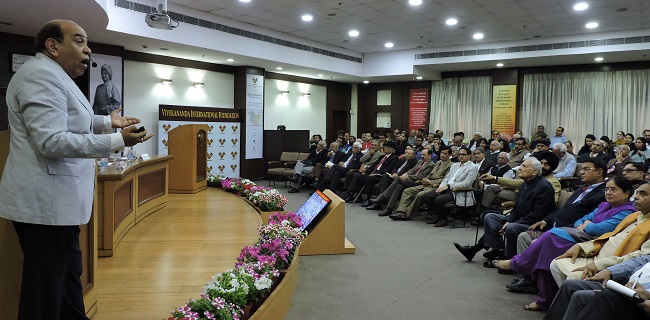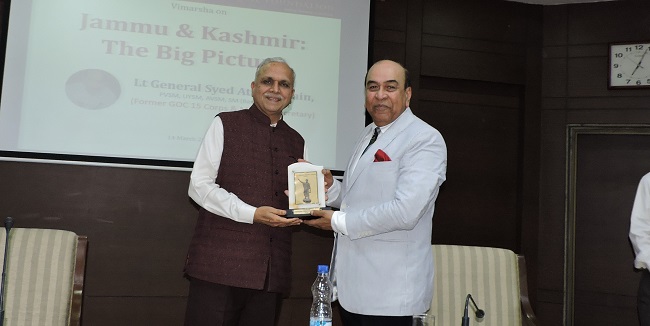

Lt General Syed Ata Hasnain, PVSM, UYSM, AVSM, SM (Bar), VSM (Bar), former General Officer Commanding of Srinagar based 15 Corps and former Military Secretary was invited to disseminate his knowledge on Jammu and Kashmir in the March edition of the Vimarsha lecture series held at the VIF. A highly decorated and experienced officer of the Indian Army, Lt Gen Hasnain enjoys great popularity in the Indian media for his knowledge of the mind and strategy of terrorist groups. Dr Arvind Gupta, Director VIF, delivered the opening remark and highlighted that the timing of this talk was very apt in the backdrop of the Pulwama attacks and the subsequent counter-attack by the Indian Air Force.
The speaker, in his initial slides, informed that Pakistan was the only strategic space in the world which is surrounded by five civilisations, thus according to it the geo-strategic salience which it enjoys today. He also said that the Line of Control (LC) in the State of J&K, unlike the other international borders, holds the two armies eyeball-to-eyeball and has one peculiar unsaid rule which dictates that ‘grabbers are keepers’. He thus pointed at the vigilance that the Indian Army requires to maintain along the LC round the clock. Gen Hasnain used colorful maps to give his audience a tour of the State of J&K, which is at the locus of all the rifts in this region for about seven decades now.

The speaker explained that the focus today was on South Kashmir. The ideological capital of the current problem in the State of (J&K) is different from its political capital Srinagar. He informed the audience that the base of radicalism and other issues was Kulgam, which is also the headquarters of the Jamaat-e-Islaami (JeI) and others. This region, he pointed, was the centre of gravity and also the granary of Kashmir, and that majority of terrorist infiltration runs from Uri to Dawar in J&K. The speaker also explained the strategic bearing of the Siachen Glacier, which the Pakistani claims to be its own. He reminded us that if we agree to vacate this area, to hold the Karakoram Range against the coopted strength of China and Pakistan together will become virtually impossible and it would further threaten the defence of the Ladakh Range. Therefore it is essential that we maintain our strength at the glaciers.
A very important aspect of the Pakistan psyche was explained by the speaker through the lens of the Zia doctrine which came into effect with the rule of Gen Zia ul Haq in 1977. The spirit of retribution against India became all the more deep seated, and manoeuvre instead of attrition was chosen as the way of fighting. Under this mindset, nuclear parity with India was deemed to be an imperative to overcome asymmetry. Gen Hasnain elucidated that the nuclear weaponry was used by Pakistan to create a perception and to befriend a rich Islamic state by christening the weapon as the ‘Islamic bomb’. He further noted that this was a typical manner of fighting hybrid war which provides flexibility and longevity with limited exhaustion of resources and comprises of conventional, irregular, cyber, economic, non-traditional, transnational, psychological, space, and most importantly, information war. In his opinion, the information space is what we need to conquer today. Alongside, political consensus in our diverse nation is the biggest non-military weapon which can outdo any threat to the national security.
The speaker tells us that in 2019 Pakistan aims at keeping India militarily and politically imbalanced. It aims at integrating the territory of J&K with Pakistan. And the intent of Pakistan’s Inter-Services Intelligence (ISI) is to regain initiative against Indian Army’s ‘Operation All-Out’ and to inflame public alienation. ‘Vilification’ of Kashmiri population is what we need to prevent on our part in a situation which the speaker identifies as the ‘last mile’. He emphasizes on overcoming the psychological, information, ideological, radical and financial aspects of this battle. Until now we have fought the hybrid war by conventional means but the General now urges us to adopt the ‘all of government approach’, which reckons each and every department of the government responsible to fight this war. He alludes to the importance of high quality governance along with the role of the army in the lead to stand up against this nature of warfare.

The new strategy of the deep state of Pakistan, as recognised by the speaker, is to create a cycle of terror, manageable Indian retribution, escalate, deescalate and then wait for the next opportunity. And in this entire cycle, the economic situation, civil society and media are in complete paralysis. Pakistan presumes China’s and Saudi Arabia’s support as guaranteed. And the option of a conventional war as a foreclosed one due to its possession of the nuclear weapons. The speaker demonstrates this as the psyche of a rogue state which does not respect that nuclear weapons are weapons of deterrence. This has only added denial, subterfuge and information operations into the modern warfare today, further stoked by the internet and social media. And to maintain an asymmetric advantage over Pakistan, the speaker is of the belief that our defence allocation must be in sync with the objective of maintaining a 1.7:1 military superiority over Pakistan. Moreover, Pakistan faces a lot of vulnerabilities from its internal dissections, which the Indian government must use to its advantage. He stresses on the need for a strategic clarity in the mind of policy makers to prevent a policy deadlock in the response options while indulging in risk calculation and climbing the rungs of the escalation ladder. He renders Post-Strike Damage Assessment as an equally important analysis to send across a strong message to the enemy force. He also imparts weight to the role of media in shaping the public opinion, which plays a huge difference as seen in the case of Pulwama attacks. And war, he asserts is the last option.
As he puts it, the aim of India in Kashmir should be to mainstream the state of J&K to rest of India through political, social, economic and psychological domains. Return of Kashmiri pundits is an essential aspect of the larger strategy. He suggests that securing the association of the Indian clergy too can be a constructive step in differentiating Islam from terrorism for our youth. Different approaches like “conversations without outcome” may be weaved into our full spectrum information strategy. In the end, he insists that a firm base be provided to armed forces of India, which will enable them to achieve our objectives.
The talk was followed by a robust discussion.
Links:
[1] https://www.vifindia.org/event/report/2019/april/02/talk-on-jammu-and-kashmir-the-big-picture
[2] http://www.facebook.com/sharer.php?title=Talk on 'Jammu & Kashmir: The Big Picture', by Lt General Syed Ata Hasnain&desc=&images=https://www.vifindia.org/sites/default/files/talk-on-jammu-and-kashmir-the-big-picture.JPG&u=https://www.vifindia.org/event/report/2019/april/02/talk-on-jammu-and-kashmir-the-big-picture
[3] http://twitter.com/share?text=Talk on 'Jammu & Kashmir: The Big Picture', by Lt General Syed Ata Hasnain&url=https://www.vifindia.org/event/report/2019/april/02/talk-on-jammu-and-kashmir-the-big-picture&via=Azure Power
[4] whatsapp://send?text=https://www.vifindia.org/event/report/2019/april/02/talk-on-jammu-and-kashmir-the-big-picture